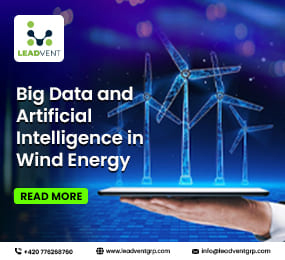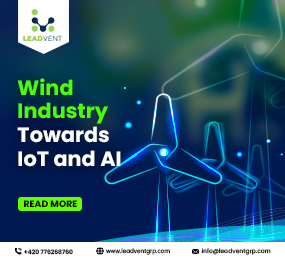A distinct transformation is happening in the global wind energy sector with digital technology adoption, especially artificial intelligence (AI). As the industry remodels itself toward a more data-centric mode, the applicability of Artificial Intelligence in Wind Energy is optimising Wind Turbine Operations and Maintenance, augmenting asset management, and enhancing efficiency on an overall scale. This blog rolls out the digitalisation journey of wind power analysis, predictive maintenance with AI, and its development that industry stakeholders are leveraging toward sustainable growth.
How AI is Revolutionising Wind Energy
AI is revolutionising the wind energy sector through improved forecasting, predictive maintenance, and asset management. AI-driven analytics are then increasing the export of energy, cutting operational costs, and enhancing turbine life.
Key Applications of Artificial Intelligence in Wind Energy:
- Predictive Maintenance: These AI-based condition monitoring systems analyze sensor data and predict the remaining useful life due to potential failure. This minimises turbine downtime and extends serviceability.
- Performance Optimisation: AI algorithms analyze and optimise wind field data and turbine performance parameters to control blade angles for maximum energy production.
- Fault Detection and Diagnosis: Anomalies in turbine component behaviour are identified by AI, which in turn allows operators to prevent further damage and avoid high-cost repairs.
- Grid Integration and Demand Forecasting: AI-based forecasting delivers strength to the grid by forewarning wind energy generation, consequently allowing influential supply-demand balancing.
- Asset Lifecycle Management: AI-enabled analytics furnish understandings for operators to support data-driven decisions about turbine replacement, refurbishment, and component upgrades.
Statistics Showing AI Impact:
- IRENA reports that AI-based predictive maintenance could bring a reduction in operational costs of up to 20%.
- Forecasting accuracy has improved by 25% because of AI-based analytics for integrating wind energy into the grid.
- A Deloitte study found that automated asset management through Artificial Intelligence in Wind Energy could enhance energy production efficiency by 10-15% for wind farms.
- AI-based implementation of automation has enhanced operational efficiency by about 30%, thereby reducing manual inspections and downtime.
Digitalisation of Wind Energy Case Studies
AI-Based Maintenance Program in a Prominent Wind Farm
A European-based wind farm executed AI-based predictive maintenance tools for monitoring turbine health, inputting real-time data from a combination of vibration sensors and temperatures. The AI was accurate in predicting bearing failures as well as gearbox issues, with a resultant 30% reduction in unplanned downtimes.
Digital Twins in Asset Management
For a digital twins application, a wind energy company in the USA looks into digital representations of wind turbines. Predictive performance evaluations and scenario analyses were applied and eventually increased energy output by 15% while optimising asset management strategy.
AI for Wind Farm Performance Optimisation
A scientifically backed investigation used AI algorithms to fine-tune turbine performance in response to continuously changing wind conditions for a leading wind farm developer. Adjustments to blade pitch and rotation speeds were dynamically undertaken to achieve 12% higher power generation efficiency and a longer lifespan for the turbines.
Wind Energy Event 2025: The Future of Digitalisation on Asset Management
Stakeholders and industry leaders are invited to converge at the Wind Energy Event to focus on the most innovative advances in wind power digitalisation and asset management. The stakeholders engage in discussion on trending topics and share case studies while networking with key opinion leaders.
Event Details:
- Date: 11 and 12 March 2025
- Location: Amsterdam, Netherlands
Key Topics Include:
- AI and machine learning applications in wind energy
- Digital twin technology for asset management
- Predictive maintenance in real-time monitoring solutions
- Big data analytics to enhance turbine efficiency
- Cybersecurity challenges for the wind energy sector
Reasons to Attend the Wind Energy Event 2025:
- Exciting updates on AI advancements in wind power analysis.
- Learn through case studies and discussions with industry experts.
- Workshops and networking opportunities with leaders in energy from around the world.
- Understand the evolution of wind energy asset management due to digital transformation.
- Discover emerging software and automation solutions assisting wind farm operations.
The Wind Energy Event 2025 creates a unique opportunity for experts and industries to partner, collaborate, and lead in digital wind energy solutions. Participants will get immersed in learning AI and wind power research from global experts through interactive panel discussions and workshops.
Conclusion
The digitalisation of wind power analysis and asset management opens up endless pathways for enhancement in efficiency, reliability, and cost-effectiveness. AI solutions are at the forefront of optimising operations, maintenance, and sustainable energy production in the Wind Turbine Operations and Maintenance. Conversely, this movement will generate cooperation among industry players in the digital transformation. The Wind Energy Event 2025 will act as the calibration platform, enabling the propulsion of the sector into an intelligent and sustainable future.
FAQs
How does AI enhance wind turbine operations and maintenance?
AI enables predictive maintenance through detector data examinations to determine potential defeats before they occur while optimising turbine performance.
What is digital twin technology in wind energy?
Digital twins are virtual parts of wind turbines that perform real-time monitoring, scenario simulation, and predictive analytics for asset management.
How does AI enhance wind energy forecasting?
AI-driven forecasting enhances accuracy by studying historical wind patterns, sensor data, and weather conditions, ensuring better grid integration.
What are the advantages of joining Wind Energy Event 2025?
Attendees will gain an understanding of AI applications, digitalisation fads, and asset management strategies while networking with industry leaders.










